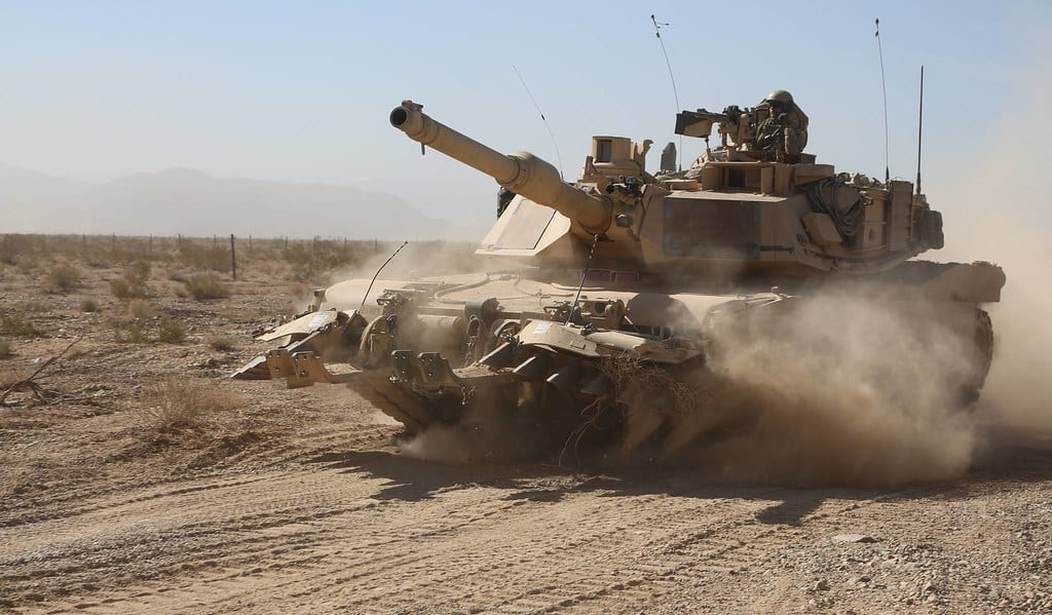Tanks on the Washington Mall? They aren’t evidence of an impending military coup; they’re a symbol of America’s military and civilian awesomeness.
A quick word on today’s special guest star, the M1 Abrams Main Battle Tank, before we get to the really juicy stuff. It’s a brief learning opportunity for those who don’t know much about this amazing machine, and a chance for those who do to bask in its glory one more time.
The M1 is 70 tons or so of fast-moving lethality. Thanks to a 1,500 horsepower gas-turbine engine much like you might find in an attack helicopter, the Abrams can reach road speeds of over 40mph. Although it can go even faster if the crews remove the engine’s speed governor, which I’m assured our perfectly-behaved tankers would never, ever do (wink, wink). That 120mm smoothbore cannon you see sticking out of the turret can reach out and touch someone, with deadly effect, while moving at top speed and at ranges of well over a mile. The latest versions feature what might be the toughest armor ever built, and have active defense systems able to knock enemy antitank missiles out of the sky. First built in 1979, the M1 remains almost freakishly survivable, highly upgradable, and is expected to remain the heart of American armored power for years to come, if not decades.
When the Army needed to counter masses of modernizing Soviet armor at West Germany’s Fulda Gap, only the best tank in the world would do — and American private industry delivered.
“OK, OK, it’s a great war machine,” some might say, “but does the M1 Abrams belong at a celebration of America’s independence from Great Britain?”
You’re damn right it does.
When the Founders published the Declaration of Independence on July 4, 1776, war had been raging for a year already. And it isn’t like the Brits read the Declaration and said (read this in your best Hugh Grant voice), “Oh, right then. Well, ah, I guess we’ll just toddle off. Best of luck and all that, old chaps. Toodle-oo.”
What actually happened when the Founders signed the Declaration, is that they’d signed their own death warrants — unless the near-impossible happened and George Washington’s Continental Army would actually emerge victorious from the ongoing Revolutionary War.
And the punishment for High Treason, for waging a losing war against King George and his armies? Hanging, drawing, and quartering — a barbarous, torturous, Medieval form of execution not banned in Britain until 1870. If you’ve ever watched Braveheart, you have a gruesome idea of what the punishment entailed — and every man who fixed his signature to the Declaration risked being subject to it.
The odds were grim in July of ’76.
Neither side enjoyed much of an army at the start, but the British ranks quickly swelled with Englishmen, Irishmen, and of course dreaded German mercenaries from Hesse. On the same day, July 2, the Continental Congress approved of the Declaration, Sir Willian Howe’s Royal forces landed at New York City and laid siege to Washington’s retreating forces at Brooklyn Heights. Quick maneuvering prevented the young American army from being pinned down and wiped out, but by mid-September Howe’s troops controlled all of New York City. By the end of the year, Washington could count fewer than 5,000 men under his command, the Continental Congress had evacuated Philadelphia, popular support for independence was in doubt, and Loyalist sentiment surged.
Nevertheless, they persisted.
On Christmas Day, 1776, Washington snuck what few troops he had on a daring raid across the Delaware River into Trenton, capturing 900 Hessians. Needless to say, Washington’s bold move helped revive American military and civilian morale. American ranks grew, and so did their fighting spirit. Up north, a British invasion from Quebec, a divide-and-conquer move designed to split New England from the rest of the country, was badly commanded by General John Burgoyne. It was also heroically resisted by American forces, who deftly used the terrain to their advantage. The resulting loss of Burgoyne’s 8,000-strong army was enough to bring France in on the side of liberty, making Saratoga one of the most important campaigns in American history.
Meanwhile, Howe took Philadelphia but could not hold it. Howe was removed from command, and Sir Henry Clinton withdrew to New York to counter possible new moves by the French. But Washington and his 14,000 men, recovered from the awful winter at Valley Forge, caught Clinton at Monmouth, New Jersey. The resulting battle was inconclusive, which for the Continental Army was as good as a win. The Battle of Monmouth was the last major fight in the north, allowing Franco-American forces to concentrate and wage the Yorktown Campaign against the main strength of the British-Hessian forces. Washington’s victory at Yorktown, with a big assist from the French, resulted in the capture of General Charles Earl Cornwallis and his army… and secured America’s independence from foreign tyranny for 243 years now.
Today is a civilian celebration of the liberty which makes America great, but it should also have an element of the military which secured that liberty in 1781, and continues to protect it to this day. The Armed Forces of the United States aren’t tools of oppression, but righteous defenders of liberty — at home and abroad.
To say they don’t deserve some small representation on this of all days, is an implicit rejection of the liberty they have fought to defend, and a furtive endorsement of the tyranny they’ve saved us from time and again.
Happy Independence Day, and let’s give tanks for the freedoms we enjoy.










Join the conversation as a VIP Member